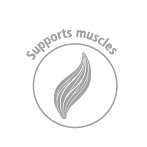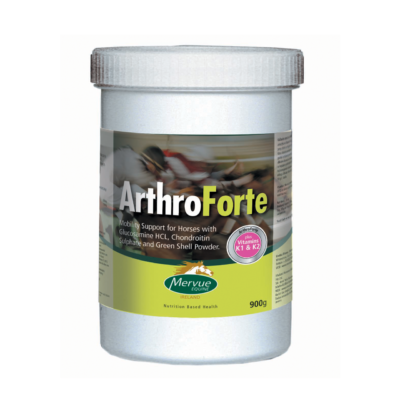- +353 21 422 0397
- info@mervue.ie
- Mon - Fri: 09:00 - 17:00
 Osteoarthritis (OA) is the most common cause of chronic lameness in horses and is a significant cause of economic loss in the equine industry due to the cost of treatment and loss of use of affected animals. The prevalence of OA varies, depending on the type and use of horses examined. It was reported at 13.9% across a range of horses in the UK, but at 97% in a group of horses over 30 years of age. Among Thoroughbred racehorses that died within 60 days of racing, 33% had at least one area of arthritis in the fetlock joint. Unfortunately, a major challenge in managing OA is that by the time clinical signs are observed (i.e. lameness), irreversible cartilage damage has already occurred.
Osteoarthritis (OA) is the most common cause of chronic lameness in horses and is a significant cause of economic loss in the equine industry due to the cost of treatment and loss of use of affected animals. The prevalence of OA varies, depending on the type and use of horses examined. It was reported at 13.9% across a range of horses in the UK, but at 97% in a group of horses over 30 years of age. Among Thoroughbred racehorses that died within 60 days of racing, 33% had at least one area of arthritis in the fetlock joint. Unfortunately, a major challenge in managing OA is that by the time clinical signs are observed (i.e. lameness), irreversible cartilage damage has already occurred.
OA can arise because of a primary bone or cartilage deficit in the joint or after trauma or as a result of normal wear and tear on a joint. The cartilage covering the ends of the bones and providing the cushioning in the joint becomes damaged and loose, this causes inflammation which results in further cartilage loss and a vicious circle develops. Ultimately all the components of the joint become affected including the bone, the cartilage, the ligaments, the synovial fluid and the joint capsule and other surrounding structures.
O A is usually diagnosed by clinical examination and x-ray. The clinical signs indicative of OA are lameness; reduced flexion and/or pain on flexion of the affected joint; poor performance and heat and swelling. Often there is a history of trauma preceding the onset of arthritis. Acute cases and severe chronic cases of OA are often managed with non-steroidal anti-inflammatory drugs (NSAIDs) which are very beneficial, but not without the potential for serious side effects especially following long term use. The main side effects observed are gastric (stomach) ulcers and kidney problems. Increasingly owners are turning to nutraceuticals to manage low grade chronic OA or to manage more advanced OA in conjunction with a lower dose of NSAIDs.
A is usually diagnosed by clinical examination and x-ray. The clinical signs indicative of OA are lameness; reduced flexion and/or pain on flexion of the affected joint; poor performance and heat and swelling. Often there is a history of trauma preceding the onset of arthritis. Acute cases and severe chronic cases of OA are often managed with non-steroidal anti-inflammatory drugs (NSAIDs) which are very beneficial, but not without the potential for serious side effects especially following long term use. The main side effects observed are gastric (stomach) ulcers and kidney problems. Increasingly owners are turning to nutraceuticals to manage low grade chronic OA or to manage more advanced OA in conjunction with a lower dose of NSAIDs.
 ARTHROFORTE is a really good answer for horses prone to or with osteoarthritis containing glucosamine, chondroitin and green-lipped mussel extract. Glucosamine, chondroitin and green-lipped mussel extract have been used for many years for the alleviation of symptoms associated with OA in humans and horses.
ARTHROFORTE is a really good answer for horses prone to or with osteoarthritis containing glucosamine, chondroitin and green-lipped mussel extract. Glucosamine, chondroitin and green-lipped mussel extract have been used for many years for the alleviation of symptoms associated with OA in humans and horses.
Glucosamine is synthesised from glucose and is an important component of cartilage. Glucosamine is a precursor for glycosaminoglycans (GAGs) which are a major component of cartilage and thus supplementation with glucosamine provides the building blocks for cartilage repair.
Chondroitin is also an important component of GAGs that provide resistance to compression within cartilage in order to avoid bone rubbing on bone. In addition to stimulating cartilage repair, chondroitin is also likely to have an anti-inflammatory effect within the joint and to also stimulate the production of hyaluronic acid, a major component of synovial fluid. Chondroitin may also inhibit the breakdown of cartilage caused by joint inflammation.
Green-lipped mussel (GLM) extract has been demonstrated to have a potent anti-inflammatory effect in arthritic joints and to improve lameness in horses affected by osteoarthritis.
ARTHROFORTE is formulated as a powder to administered in food. Adult horses should receive 30g (2 spoonfuls) daily and foals one spoonful daily. Arthroforte should be introduced gradually.
Copyright © 2019 Mervue Laboratories. All Rights Reserved.